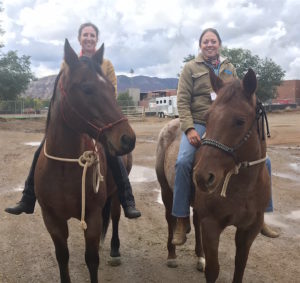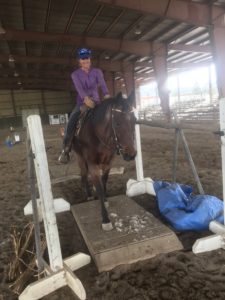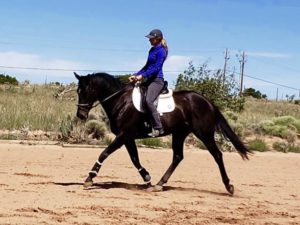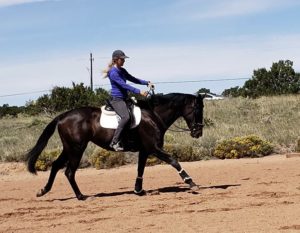 Editor’s Note: 2018 Best Horse Practices Summit presenter Katrin Silva grew up riding dressage in Germany before moving to the United States at age 19 to learn to ride Western. She’s been riding both disciplines for the last twenty years and is a regular guest columnist for Cayuse Communications. She lives in New Mexico where she works with dressage and Western clients. Visit her blog here.
Editor’s Note: 2018 Best Horse Practices Summit presenter Katrin Silva grew up riding dressage in Germany before moving to the United States at age 19 to learn to ride Western. She’s been riding both disciplines for the last twenty years and is a regular guest columnist for Cayuse Communications. She lives in New Mexico where she works with dressage and Western clients. Visit her blog here.
Silva has developed an ongoing series titled “Divide Ain’t Wide” which compares Western and dressage riding styles, history, and techniques. Check out more here.
In this piece, Silva considers conversations between horse and rider.
Silva writes:
I think of riding as communication, a dialogue between horse and human. As with other conversations, sometimes we understand each other perfectly, sometimes less so.

These horses are enjoying the ride and the company
The type of tack has nothing to do with the quality of the horse-rider conversation. But the style of riding does influence its tone. For example, western riding is based on a working tradition, with practical goals like roping a steer or checking a fence. Horse and rider have to focus on something other than riding at least some of the time. As a result, we have to trust each other without constantly checking in.
Here’s an example of a conversation I had last summer when I was on a trail ride with a friend on the huge ranch in northern New Mexico. I was riding an old buckskin horse named Big’un who really knew the terrain and his job:
“Hey, Big’un?”
“Yeah?”
“Let’s jog up that fence line.”
“Sure.”
“Just follow Christina’s horse.”
“You silly person. I would have done that anyway.”
10 minutes pass
“Turn left.”
“Done!”
More time passes
“Think we can lope for a while? Otherwise it might get dark by the time we get home. ”
“I don’t see why not.”
“Thanks!”
More time passes
“Whoa. Time for a walk break. Don’t want you to get home all sweaty.”
“It’s about time! Thank you”

Western horses need to negotiate obstacles without too much talk
You get the idea. Like the dialogue of an old Western movie, our communication uses few words and wastes none. Pauses are comfortable and don’t need to be filled with idle chatter. A good Western horse knows his job and does not need constant reminders on how to do it. No talk is better than small talk because we may have other things to worry about, like a rope or a cow, or even a human-to-human conversation with a friend on a relaxing trail ride.
In dressage, the opposite is true: riding happens for the sake of riding, not for any other, more practical reason. Horse and rider tend to focus exclusively on each other. Their conversation demands every bit of each partners’ attention, which is why there are more words, longer sentences, and fewer moments of silence. This is a conversation I had with a quarter horse named Houston who I used to show at Second Level. Houston was always eager to please, but could be a bit of a worrywart when we entered at A:
“Hey, are you listening to me?”
“What? Oh, sorry, I was daydreaming about that cute Andalusian mare I saw in the warm-up pen. Now I am.”
“Dude, it would never work out. She’s out of your league. Ready to trot up centerline?”
“Just a second . . . turn now? Now?”
“Ok, let’s go! . . . no, not like that. You’re shuffling. Pick up your hind feet!”
“Like this?”

Focused dressage horse with engaging conversation
“Yes, but don’t rush, either.”
“Ok, I get it. Like that?”
Yes, but don’t wiggle. Stay straight.”
“Geez, make up your mind. Like that?”
“Yes, thank you.“
“Well, hallelujah! Are you finally happy with my trot?”
“It’s great now, except we need to halt at X. Almost there, get ready!”
“Got it! Now?”
“Not yet . . . now!”
“Was that good? It was, wasn’t it? Please say it was good! ”
“Yes, it was. Thank you,. But your left hind foot is parked way out behind you. Bring it up, please.”
“Yeah, yeah . . . I think standing square is overrated, but whatever. Trot again? I know you want to! Can I? Can I?”
“Wait til I’m done saluting the judge!”
“Are you done yet? Hurry up, I want to trot!”
“Not quite . . . ok, now.”

Even dressage conversations need moments of silence, in this case, loose rein contact
“What’s next? Oh, wait, that judge looks scary. I don’t want to go that way!”
“Don’t be such a chicken! She won’t eat you.”
“She looks like she might!”
“Please move forward . . .”
“No, I won’t!”
“ . . . or I’ll use my whip!”
“Ok, ok, I guess you’re right. She just looks scary. I’ll scoot by her booth and throw her a dirty look. That will show her.”
“Thank you! Ready for the shoulder-in?”
“Yes, you know this is my good direction. Like this?”
“A little more bend, come on, I know you can do it! No, not just your neck, that’s cheating.”
“I was hoping you wouldn’t notice. Ok, is that better?”
. . . and so on. You get the idea.
Western conversation pros and cons
In a conversation between a Western horse and his rider, every word means something. The moments of silence in the dialogue can have a reassuring, confidence-boosting effect.
On the other hand, too much silence and too many unsaid words can become a source of misunderstanding. When horse and rider don’t check in with each other often enough, communication can break down. Horses can stop listening to their riders, sometimes without their riders noticing, and just go on autopilot.
Dressage conversation pros and cons
In the dressage conversation, the opposite extreme is a bigger risk: Constant reminding and checking-in can easily turn into nagging. A horse learns to tune out and ignore rider signals, which leads to unwillingness and resistance. Micromanaging a horse does not build the kind of trust and respect we are all looking for.
Rather than think of Western and dressage as two completely different communication styles, I have learned to think of successful horse-rider connection as a sliding scale, with ranch work at one end and classical dressage as an art form at the other. Both work. But neither is right all the time. Good riders know when to talk and when to shut up. They also know that their communication varies depending on the horse and the situation.
Horses can benefit from both worlds. Every well-trained horse should be able to focus on his rider in the way good dressage horses do. It feels so amazing when it’s right (which is about 10 percent of the time, if you’re lucky). But every good horse should also be able to go on a loose rein down a trail without constant rider reassurance.
Similarly, every good rider should develop enough feel, timing, coordination, and focus, to have a subtle, polite, and ongoing conversation with her horse. But at the other end of this sliding, conversational scale, every good rider should also have enough trust in the horse and enough mental discipline to leave the horse alone for a few strides or a few minutes. Trust, respect and harmony can only develop in the interplay of words and silence, the lines of dialogue and the deep breaths between them.
Great explanation if the differences, pros and cons! Thank you!
I really enjoyed seeing you and Amy Skinner work so well together at the Best Horse Practices Summit. Seeing how the dressage work benefits all horses/disciplines was helpful.
Hi Bonnie, thank you for tasking the time to comment! Amy and I loved presenting to such a supportive audience. Dressage has its issues as a sport, but if you strip away the nonessentials, it’s a path to a happy, sound horse that’s really fun to ride.
Hi Bonnie, thank you for taking the time to comment, and thank you for the positive feedback. Amy and I enjoyed presenting in front of such an interested, knowledgeable, and receptive audience. We could not have pulled it off without you!
I never thought about the differences in this way. Great article.
Thank you, Patricia!
Wonderful article, Katrin, to describe the different conversations in “perceived” completely opposite riding methods. I put “perceived” in quotes as you have shown us with your riding at the Summit and with other articles, the divide isn’t so wide between ranch and dressage riding. You wrote here two different conversations that riders could have with their horses in two different riding styles. Love it!! Makes total sense.
Thank you, Julie! I had fun transcribing these conversations.